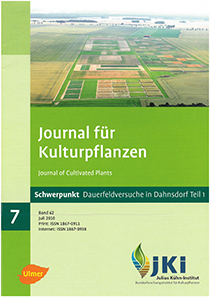Occurrence and control of diseases in winter cereals in a long-term trial at the experimental field in Dahnsdorf (Brandenburg)
DOI:
https://doi.org/10.5073/JfK.2010.07.03Keywords:
Plant protection strategies, leaf diseases, winter cereals, fungicide use, necessary minimumAbstract
In a long-term trial entitled “Strategy comparison – environmentally friendly plant protection”, the control of fungal diseases was studied in two crop rotations in order to determine the necessary minimum of pesticide use. Foliar disease control is not subject to long-term effects. Therefore, the effects of treatment must to be assessed for each individual year according to the respective severity of disease occurrence.
Dominant diseases were brown rust (Puccinia recondita) and Rhynchosporium leaf spot (Rhynchosporium secalis) in winter rye, net blotch (Pyrenophora teres) in winter barley, and Septoria leaf blotch (Mycosphaerella graminicola) in winter wheat. The severity of these and other diseases was mainly determined by the annual weather-dependent infection pressure and cultivar susceptibility to disease.
Fungicides were dosed at two intensities: 100% (situation-dependent) and 50% (reduced dosage), in each case, after a certain disease threshold was exceeded. Both intensity levels achieved good to very good fungicidal effectiveness, but the effectiveness of the lower dosage level was often significantly lower at high infestation levels.
Overall (11 years), the mean treatment frequency index was 1.4 in winter rye, 1.0 in winter barley, and 0.8 in winter wheat.
Cultivar resistance proved to be the determining factor of the need for fungicide treatment. In winter rye and winter barley, where resistance to the dominant diseases was rather low, at least one fungicide treatment was necessary in all years studied. In the highly resistant winter wheat cultivar Pegassos, on the other hand, moderate to higher infestation occurred in only three years, and no fungicide treatment was required in three years.
Generally, fungicide use was economically beneficial only in years with high infestation levels and weather conditions favourable for yield formation. Significant yield increases were obtained at both fungicide dose levels in 7 years in winter rye and in 6 years in winter barley, but the fungicide-related yield increases and profits achieved in the 50% group were roughly half those achieved in the 100% group. In winter wheat, a distinct benefit was achieved in only 3 years, but it was higher in the 50% group than in the 100 % group. Treatment resulted in little to no yield increase and generally no profitability benefit in years with above-threshold infestation but low-to-moderate disease development or extended dry spells, particularly in the pre-summer period.
Downloads
Published
Issue
Section
License
The content of the journal is licensed under the Creative Commons Attribution 4.0 License. Any user is free to share and adapt (remix, transform, build upon) the content as long as the original publication is attributed (authors, title, year, journal, issue, pages).
The copyright of the published work remains with the authors. The authors grant the Journal of Cultivated Plants, the Julius Kühn-Institut and the OpenAgrar repository the non-exclusive right to distribute and exploit the work.







